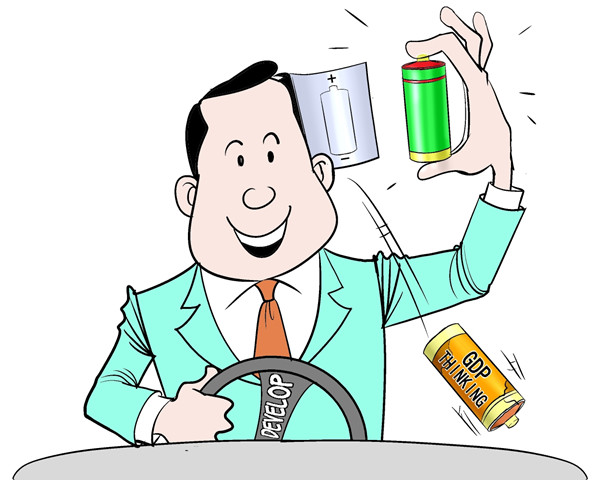Environment must be a priority
- By Zhang Kai
 0 Comment(s)
0 Comment(s) Print
Print E-mail China Daily, November 7, 2013
E-mail China Daily, November 7, 2013
People from all walks of life are hoping the upcoming Third Plenary Session of 18th Communist Party of China Central Committee will signal that the government and the Party are attaching greater importance to environmental protection.
|
|
|
A change of gear [By Jiao Haiyang/China.org.cn] |
Thanks to reform, demographic, and environmental dividends, China's economy has developed rapidly over the past two decades, and the country's GDP reached 51.9 trillion yuan ($8.3 trillion) in 2012, 6.87 times that of 2000. However, this has been accompanied by growing threats to the environment. Industrial emissions in 2011 were 4.88 times more than the emissions in 2000. Hazardous air pollution has plagued many Chinese cities in the recent years, and in some areas industrial discharges have polluted the environment to a dangerous extent.
The smog and haze that blanketed a large swathe of the country at the beginning of 2013 and the contaminated rivers and rice scandals that followed increased people's awareness of the poisoning of the land and air and fueled public anger. As a result, tackling environmental degradation has become a priority problem for China's new leadership.
The government released China's Action Plan for Prevention and Control of Air Pollution in September, which admitted the country's air pollution is "severe" and harming people's health and is now a threat to social stability. It provides a road map for air pollution control over the next five years, focusing on three key regions, the Beijing-Tianjin-Hebei area, the Yangtze River Delta and the Pearl River Delta.
It set the goals of reducing the concentration of PM 2.5 - those particles smaller than 2.5 microns in diameter, which can penetrate deep into the lungs - by 25 percent by 2017 in the Beijing-Tianjin-Hebei area, 20 percent in the Yangtze Delta, and 15 percent in the Pearl River Delta, and put forward 10 measures to achieve these targets, including strengthening treatment efforts to reduce multi-pollutant emissions; accelerating the adjustment of energy structures to increase clean energy supply; and improving the legal system to conduct stricter supervision and management.
This is a change of strategy from the 12th Five-Year Plan (2011-15) on air pollution, which aimed to reduce the concentration of PM 2.5 by 6 percent from 2010 levels in the three regions through end-of-pipe treatment, such as desulfurization and denitration.
Hard on the heels of the action plan, the State Council issued the Guidelines to Tackle Serious Production Overcapacity in October, which demonstrated the new government's commitment to curbing excess production capacity and eliminating outdated capacity. The guidelines require cutting 80 million tons of capacity in the steel sector over the next five years and impose punitive electricity and water prices on sectors with severe overcapacity.
But while these are positive moves, whether the transformation to cleaner air will be successful or not, largely depends on whether the country can reduce its coal consumption.
China's coal-fired power stations and heavy industries, such as cement and steel are mainly responsible for burning coal, which is the largest source of China's air pollution, contributing about 45 percent of all PM 2.5 emissions.
If the coal burning of these industries can be curbed, and the target of reducing coal consumption by 83 million tonnes in Beijing, Tianjin, Hebei, and Shandong can be attained this will be a good start to achieving better air quality.
But this target only covers Beijing, Tianjin, Hebei, and Shandong, no specific goals have been set for the Yangtze River Delta and the Pearl River Delta regions, as well as the large coal-producing provinces such as Shanxi and the Inner Mongolia autonomous region.
If China's new government is to effectively protect the environment, it has to introduce stringent administrative and economic measures to reduce the use of coal. For one thing, the targets for cutting coal consumption in Hebei, Shandong, Tianjin and Beijing have to be expanded to other regions as well.
The subsidizing of high pollution enterprises at the cost of public health as has been the case in past decades must be changed. The authorities are expected to push forward a carbon tax and a resources tax in a bid to gradually increase the cost of burning coal, and people expect the upcoming Plenary Session to result in other measures to improve the health of the environment.
The author is Greenpeace Climate & Energy Campaigner.






